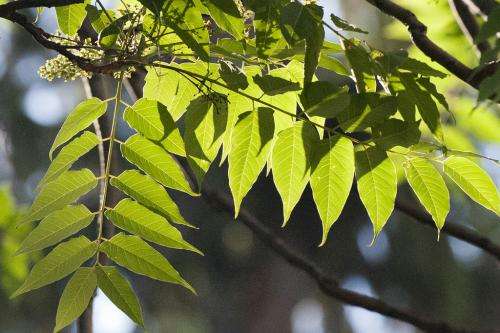Ailanthus tree's status as invasive species offers lesson in human interaction

An exotic tree species that changed from prized possession to forest management nightmare serves as a lesson in the unpredictability of non-native species mixing with human interactions, according to researchers.
"There are other invasive tree species in Pennsylvania, but the Ailanthus, by far, has been here longer and does more damage than any other invasive tree," said Matthew Kasson, who received his doctorate in plant pathology and environmental microbiology from Penn State. "It's the number one cause of native regeneration failure in clearcuts in Pennsylvania."
Kasson, who is a post-doctoral researcher in plant pathology, physiology and weed science at Virginia Tech, said that William Hamilton, a pioneer botanist who corresponded with William Bartram and Thomas Jefferson, imported the first Ailanthus altissima—Tree-of-Heaven—a tree native to China, from England sometime between 1784 and 1785 and cultivated the tree on his estate, the Woodlands, in Philadelphia. The deciduous tree, which grows rapidly, often to a height of 50 feet, has become one of the biggest forest management problems, especially since the 1980s, according to the researchers.
Kasson and colleagues report in a recent issue of the Northeastern Naturalist that Ailanthus can invade quickly in areas where large, continuous stands of trees are cut down—clearcuts—and displace slower-growing native plants. The spread of Ailanthus in Pennsylvania occurred in spurts that seem to be connected with stages of human development, particularly during cross-state transportation projects, Kasson said.
While the tree was initially isolated to the properties of a few botanists and wealthy plant collectors, commercialization of Ailanthus after 1820 coupled with railroad construction projects that connected the eastern and western parts of the state in the mid-1800s intensified its spread, according to Kasson, who worked with Matthew Davis, lab assistant and Donald Davis, professor of plant pathology, both of Penn State.

In the 1980s, widespread gypsy moth infestation in Pennsylvania led to the death or near death of large stands of oak trees in the state forests, especially in south-central Pennsylvania. Crews that cut down the trees built roads to reach the sites, which became avenues for the spread of Ailanthus. From 1989 to 2004 the number of Ailanthus trees on inventory plots increased from 76 million to 135 million.
"In parts of the state forests there were no roads in areas associated with the gypsy moth devastation," said Kasson. "During these timber salvage operations, crews are building roads and moving a lot of soil and seed."
The researchers found one or two older female Ailanthus trees near areas where foresters removed trees following the gypsy moth infestation, but also discovered that most of the Ailanthus trees started to grow shortly after the clearing operation. The older seed-producing trees were often found upwind from the sites of the recent Ailanthus growth. Kasson said this indicates that following the clearcut Ailanthus grew faster than competing species and quickly dominated these forests.
Kasson said recent mining and drilling operations in Pennsylvania forests may also cause the species to expand.
"New roads are being constructed into these active drilling sites," said Kasson. "These drilling operations could lead to future spread."
Previous research may have also underestimated how long Ailanthus can live, according to Kasson. While prior studies estimated that Ailanthus's lifespan was between 50 to 75 years, the tree routinely lives longer than 100 years.
The researchers conducted tree-ring studies of Ailanthus in all the counties where the tree grows in Pennsylvania, as well as several surrounding states. The researchers used these studies, along with historic surveys and reports on plant species in the state, to determine age and growth patterns.
Ailanthus, which is also called Chinese sumac or stinking sumac, grows in 60 of Pennsylvania's 67 counties, according to the researchers—nine more counties than reported in previous studies. The research also suggests that the incidence of Ailanthus in Pennsylvania's northern-tier counties, where the tree has been historically absent, will likely increase like previous Ailanthus expansions in southern parts of the state.
Provided by Pennsylvania State University
















